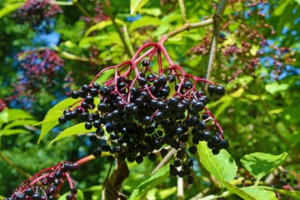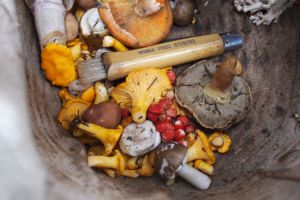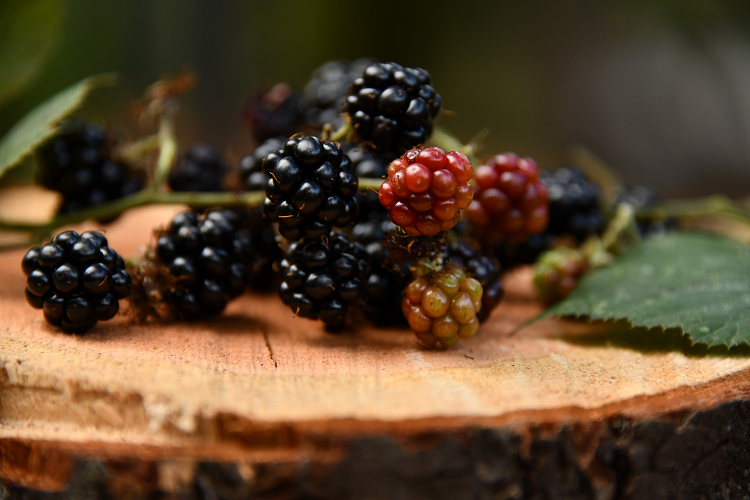Foraging for Opportunities (FWN 29)
20 September 2017There is an abundance of delicious and nutritious wild food that can be found in Scottish woodland, hedgerows and moorland.
A growing interest in fresh, seasonal and local food is leading to a resurgence in wild-harvesting or foraging. There is upwards of over 300 different species of edible botanicals that are foraged in Scotland, from the well-known brambles, mushrooms and wild garlic through to dulse seaweed, sweet cicely and sea buckthorn. The vast majority of foraged foods are collected by people keen to reconnect with the land and learn more about indigenous, natural food and are collected for personal use to make jams, chutneys, soups etc. In recent years foraged berries, herbs, mushrooms and edible plants have started to make an appearance in some of Scotland’s most innovative restaurants and forward-thinking food and drink processors, creating a diversification opportunity for woodland owners.
Due to the large abundance of different species available in Scotland, foraging can take place all year round.
- Winter – coastal regions are abundant with large varieties of seaweed. Currently, in Scotland, there are over 20 seaweeds foraged and eaten with five currently being picked for commercial use by large scale producers.

- Spring – green botanicals are abundant. These include wild watercress, sweet cicely, wild garlic, wood sorrel, bittercress and even a number of invasive species including giant hogweed.
- Summer – foraging in summer moves on to edible flowers, seeds, grains, nuts and berries. The majority of berries, which include brambles, sea buckthorn, rowan berries, lingonberries and bilberries, are picked for personal use to make jams, jellies and chutneys. Edible flowers including apple mint, sweet chamomile, elder and juniper are used by the restaurant trade and by distilleries, especially the gin producers who use juniper berries.
- Autumn – primarily used for picking mushrooms and fungi. There are 20-30 varieties of fungi picked in Scotland with approx. five picked for commercial use. These include chanterelles, morel and ceps (porcini).
To make foraging a commercially viable activity, foragers will pick a variety of different products throughout the year depending on what is in season. The price they can sell foraged foods depends on the abundance of the product, the time taken for foraging and demand from the food and drink industry. Most foragers will sell directly to restaurants or will supply large wholesalers and are paid per 100g of product.
The best place to find foraged ingredients is in broadleaf woodland. The further south you are, the longer the seasons are for foraging, but most of the Scottish woodlands can be foraged for wild foods. There are also geographical pockets in Scotland which have their own micro-climate that are wonderful places to forage for a diverse range of natural foods. Broadleaf woodland with its diverse mix and age of species and with its variable habitats is the ideal place to find wild foods that can be abundant throughout the woodland. Woodland near extensive farming areas can be affected by chemical drift which can have a negative effect on the quantity and variety of species available. Plantation woodlands where single species of trees are grown are not usually suitable for foraging unless you limit your picking to the edges of the plantations. Hedgerows are also excellent places for finding wild foods.
In Scotland, the “right to roam” under the Land Reform (Scotland) Act 2003 permits foragers to use all land, public or private, for recreation, education and access with only a few restrictions. This allows foragers the right to forage for materials for personal consumption and for teaching but not the right to uproot. It is recommended that foragers only pick 20% of a species at any one place to ensure each species is not over picked. For foraging for commercial use, foragers need permission from the landowner.
For those interested in foraging, it is highly recommended that they attend a foraging tour or course. A good number of expert foragers offer courses on responsible foraging showing participants what to look out for, what to expect in each season and how to harvest sustainably. The following are a good source of information:
- The Scottish Wild Harvests Association provides information about wild harvesting in Scotland.
- Association of Foragers provides a list of local foraging educators running courses, workshops and events.
- The British Botanical Society Code of Conduct leaflet gives a good overview of how to responsibly and legally enjoy wild foods.
With regard to commercial use, wild berries are becoming very popular in the drinks industry. A number of gin distilleries use foraged ingredients, in particular juniper berries, to flavour their gin products. The distilleries have agreements with local landowners to pick a certain amount of berries from local forests (with the necessary approvals in place). Common practice is for woodland owners to get advice from foraging experts but pick the products themselves, or to hire local foragers to pick for them. It is also common for organisations to get a health analysis carried out on the juniper to check if it is suitable for use and if picking will be sustainable.
Elderberry is also becoming a very popular ingredient with a whisky producer using it for production of elderberry whisky liquor. They pick approximately one tonne of elderberries from East Lothian themselves over the four-week harvest. They then de-stem and process the fruits to produce a syrup which they freeze or use to make the liquor. The producer is looking for a guaranteed supply of high-quality elderberries and, whilst they are considering planting and harvesting themselves, this can result in additional problems as wild products can be extremely difficult to cultivate.
There are a number of drink producers that use sea buckthorn in their products. An apple Juice manufacturer adds foraged sea buckthorn to their juice which adds additional health benefits to the final product. There is also a sea buckthorn drinks producer from East Lothian that has a sustainable harvesting agreement with East Lothian Council. They harvest the berries themselves over the winter months and then pasteurise and bottle before selling to shops and restaurants in Edinburgh, Glasgow and London.
There are a number of ongoing issues in the foraging sector that may have to be overcome if the sector is going to expand and grow. At the moment there are no systems in place to check the quality and health of the foraged produce. The system completely relies on the trust between end-users and the forager. Some of the well-established foragers keep records of what and how much they pick which can help with traceability and standards of the materials.
An area that may also have to be revamped is the process of getting permission from landowners to forage on their lands. If the sector is going to expand and thrive there needs to be a system were foragers can obtain long term permissions. Foragers are keen to point out to landowners that they can act as additional stewards of the land. It is in the forager’s best interest to preserve the land and to ensure plants prosper and grow so they can go back and pick the following year. Foragers would encourage all landowners to learn about foraging and the benefits foraging can bring to their lands.
Alistair Trail, Food and Drink Consultant, SAC Consulting
Sign up to the FAS newsletter
Receive updates on news, events and publications from Scotland’s Farm Advisory Service

